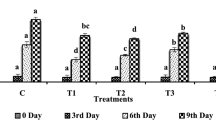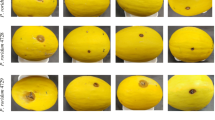Abstract
Brazilian green propolis extract (PP) and cinnamon oil (CM) as edible coatings can be used to maximize chilli shelf life due to their antifungal properties. Antifungal effects and quality control of 5 % PP, 0.1 % CM and the combination of PP and CM incorporated with 5 % gum arabic (GA) as base coating were investigated in vitro as well as in vivo. Coated chillies were stored in cold storage of 13 ± 2 °C (80–90 % relative humidity (RH)) for 28 days and 5 days at simulated marketing conditions (25 ± 2 °C, 60–70 % RH). Study revealed that PP and CM alone had fungicidal effect against Colletotrichum capsici, causal organisms of chilli anthracnose. However, combined treatment of PP and CM showed the most promising results against C. capsici with 100 % inhibition on mycelia growth and spore germination. In vivo studies revealed that combined treatment of PP and CM showed a significantly (p < 0.05) lower disease incidence (14 %) and severity score (1.5) after 33 days of storage, as well as a significant delay in the changes of weight loss, firmness, peel colour and soluble solids concentration compared with other treatments. It could be concluded that 5 % PP combined with 0.1 % CM incorporated with 5 % base coating of GA is an effective bio-fungicide for postharvest anthracnose control and retaining the quality of chilli.



Similar content being viewed by others
Abbreviations
- PP:
-
Brazilian green propolis extract
- CM:
-
Cinnamon oil
- GA:
-
Gum arabic
References
Ali, B. H., Ziada, A., & Blunden, G. (2009). Biological effects of gum arabic: a review of some recent research. Food and Chemical Toxicology, 47, 1–8.
Ali, A., Maqbool, M., Ramachandran, S., & Alderson, P. G. (2010). Gum arabic as a novel edible coating for enhancing shelf-life and improving postharvest quality of tomato (Solanum lycopersicum L.) fruit. Postharvest Biology and Technology, 58, 42–47.
AOAC. (1984). Official Methods of Analysis (14th ed.). Washington: Association of Official Analytical Chemists.
AVRDC. (1998). AVRDC Annual Report 1997, Tainan, Taiwan, pp. 54-57.
Aza-González, C., Núñez-Palenius, H. G., & Ochoa-Alejo, N. (2012). Molecular biology of chili pepper anthocyanin biosynthesis. Journal of the Mexican Chemical Society, 56, 93–98.
Baldwin, E. A., Nisperos-Carriedo, M., Shaw, P. E., & Burns, J. K. (1995). Effect of coatings and prolonged storage conditions on fresh orange flavour volatiles, degrees brix and ascorbic acid levels. Journal of Agricultural and Food Chemistry, 43, 1321–1331.
Bankova, V. (2005). Recent trends and important developments in propolis research. Journal of Evidence-Based Complementary and Alternative Medicine, 2, 29–32.
Barnett, H. L., & Hunter, B. B. (1972). Illustrated genera of imperfect fungi (p. 24). Broken Arrow: Burgess Publishing Co.
Ben-Yehoshua, S. (1969). Gas exchange, transportation and the commercial deterioration in storage of orange fruit. Journal of the American Society for Horticultural Science, 94, 524.
Berrera-Necha, L. L., Bautista-Baños, S., Flores-Moctezuma, H. E., & Rojas-Estudillo, A. (2008). Efficacy of essential oils on the conidial germination, growth of Colletotrichum gloeosporioides (Penz.) Penz. and Sacc and control of postharvest diseases in papaya (Carica papaya L.). Plant Pathology, 7, 1–5.
Cronin, M. J., Yohalem, D. S., Harris, R. F., & Andrews, J. H. (1996). Putative mechanism and dynamics of inhibition of the apple scab pathogen Venturia inaequalis by compost extracts. Soil Biology and Biochemistry, 28, 1241–1249.
Giovanelli, L. C. (2008). Evaluation of an Ethanolic Extract of Propolis as a Potential Pre- and Post-Harvest Fungicide for ‘Fuerte’ Avocado (Persea americana Mill.) Fruits and Orchards. Johannesburg: Faculty of Science, University of the Witwatersrand.
Gupta, C., Garg, A. P., Uniyal, R. C., & Kumari, A. (2008). Comparative analysis of the antimicrobial activity of cinnamon oil and cinnamon extract onsomefood-borne. African Journal of Microbiology Research, 9, 247–251.
Hernández-Munoz, P., Almenar, E., Valle, V. D., Velez, D., & Gavara, R. (2008). Effect of chitosan coating combined with postharvest calcium treatment on strawberry (Fragaria x ananassa) quality during refrigerated storage. Food Chemistry, 110, 428–435.
Maqbool, M., Ali, A., Alderson, P. G., Mohamed, M. T. M., Siddiqui, Y., & Zahid, N. (2011). Postharvest application of gum arabic and essential oils for controlling anthracnose and quality of banana and papaya during cold storage. Postharvest Biology and Technology, 62, 71–76.
McGuire, R. G. (1992). Reporting of objective color measurements. HortScience, 27, 1254–1260.
Messerli, S. M., Ahn, M. R., Kunimasa, K., Yanagihara, M., Tatefuji, T., Hashimoto, K., et al. (2009). Artepillin C (ARC) in Brazilian green propolis selectively blocks oncogenic PAK1 signaling and suppresses the growth of NF tumors in mice. Phytotherapy Research, 23, 423–427.
Pan, J. C., & Bhowmilk, S. R. (1992). Shelf-life of mature green tomatoes stored in controlled atmosphere and high humidity. Journal of Food Science, 57, 948–953.
Park, H. J. (1999). Development of advanced edible coatings for fruits. Trends in Food Science and Technology, 10, 254–260.
Roberts, P.D., K.L. Pernezny & T.A. Kucharek. (2001). Anthracnose caused by Colletotrichum spp. on pepper. Available at: http://edis.ifas.ufl.edu. Assessed on 12th May 2013.
Sivakumar, D., Hewarathgamagae, N. K., Wijeratnam, R. S. W., & Wijesundera, R. L. C. (2002). Effect of ammonium carbonate and sodium bicarbonate on anthracnose of papaya. Phytoparasitica, 30, 1–7.
Sydow, H. (1913). Beitrage zur kenntnis der PilzHora des Siidlichen Ostindiens-I. Anv. Myc, XI, p. 329.
Win, N. K. K., Jitareerat, P., Kanlayanarat, S., & Sangchote, S. (2007). Effects of cinnamon extract, chitosan coating, hot water treatment and their combinations on crown rot disease and quality of banana fruit. Postharvest Biology and Technology, 45, 333–340.
Yaman, O., & Bayoindirli, L. (2002). Effects of an edible coating and cold storage on shelf-life and quality of cherries. Lebensmittel-Wissenschaft and Technologie, 35, 146–150.
Zahid, N., Ali, A., Siddiqui, Y., & Maqbool, M. (2013). Efficacy of ethanolic extract of propolis in maintaining postharvest quality of dragon fruit during storage. Postharvest Biology and Technology, 79, 69–72.
Zapata, P. J., Guillén, F., Martínez-Romero, D., Castillo, S., Valero, D., & Serrano, M. (2008). Use of alginate or zein as edible coatings to delay postharvest ripening process and to maintain tomato (Solanum lycopersicon Mill) quality. Journal of the Science of Food and Agriculture, 88, 1287–1293.
Acknowledgments
We are grateful to the Ministry of Agriculture, Malaysia (MOA) for providing financial support under project grant No. 05-02-12-SF1003.
Author information
Authors and Affiliations
Corresponding author
Rights and permissions
About this article
Cite this article
Ali, A., Chow, W.L., Zahid, N. et al. Efficacy of Propolis and Cinnamon Oil Coating in Controlling Post-Harvest Anthracnose and Quality of Chilli (Capsicum annuum L.) during Cold Storage. Food Bioprocess Technol 7, 2742–2748 (2014). https://doi.org/10.1007/s11947-013-1237-y
Received:
Accepted:
Published:
Issue Date:
DOI: https://doi.org/10.1007/s11947-013-1237-y




